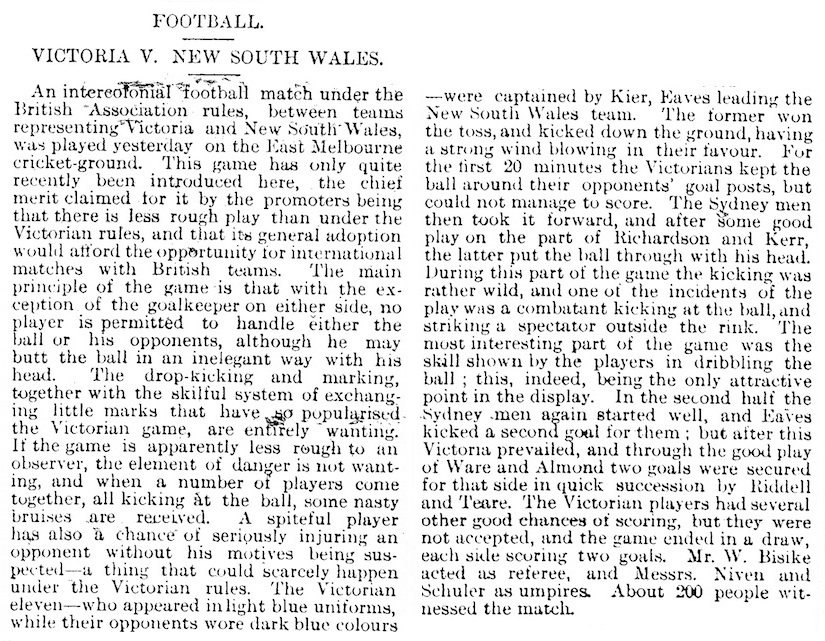The start of the codified game
The Anglo-Australian Football Club was formed in Melbourne in 1883. Early intra-club matches were played at Albert Park before the Richmond Cricket Ground (the present-day Punt Road Oval) was secured in May. Upwards of a dozen scratch matches were played by the club, in addition to some games against Australian Rules teams.
Intercolonial matches between Victoria and New South Wales began in the same year. Two 'tests' were played in August, at the East Melbourne and South Melbourne cricket grounds, both ending in draws.
The British Association game was not received with overwhelming enthusiasm by the media. According to the Argus:
The English game bears about the same relation to the Victorian game that bowls does to cricket. It is not nearly so rough as the Victorian pastime, nor so exciting to the spectator; but on the other hand, the tactics are far less likely to provoke ill-feeling and deliberate ill-usage.

The Age was more blunt:
The one recommendation the British Association game, as played yesterday, has over the Victorian game is that it is not so rough. It is mild to the extent of implying physical degeneracy on the part of a community which plays it, and it is altogether unlikely to become popular here.
The Argus probed more deeply:
If the game is apparently less rough to an observer, the element of danger is not wanting, and when a number of players come together, all kicking at the ball, some nasty bruises are received. A spiteful player has also a chance of seriously injuring an opponent without his motives being suspected—a thing which could scarcely happen under the Victorian rules.
So the footballers are not only degenerate but sneaky, too. They would not involve themselves in the manly violence of Australian Rules but resorted instead to surreptitious and underhand mayhem. These charges being laid against the ‘imported men’ who played the game in 1883 were to resurface in almost identical terms in the 1950s and 1960s when directed against another generation of immigrants.
In 1884 a meeting at Young and Jackson’s in Melbourne established the Anglo-Australian Football Club, playing under British Football Association rules and this provided Football Federation Victoria with cause to celebrate a 125th anniversary of football in 2009. Arthur E. Gibbs was one of the most influential of the pioneering generation. Player, referee and administrator he went on to represent Australia on the Football Association Council for many years.
Large-scale immigration resumed in the 1880s. The rate of net inflow relative to the domestic population was the highest it had been since the gold rush days. Between the 1880s and the early 1900s, Association football had established itself in all parts of Australia. It was very much a migrants' game in these years, with strong Scottish influence in many areas. Relationships with other codes varied from cool to cooperative, with some sharing of facilities and a fair amount of mutual slanging. Regular club matches were underway for a variety of trophies, some played on a league basis, others as knock-out cup competitions. The rules adopted were those of the Football Association in England, and the sport was totally amateur.
In Victoria the game rose somewhat in the social scale, if not in popular support, with the Governor Sir H. B. Loch acting as patron of a series of three intercolonial matches in 1887 and attending one game in the company of Lord Carrington and the Mayor of Sydney. Two of the matches were played at the Melbourne Cricket Ground, the other at East Melbourne. At the dinner after the drawn game, the New South Wales captain, William Baillie, stated that ‘had it not been for bad trade and other circumstances he would have been able to have brought a much stronger team with him to Victoria’. Demonstrations by the unemployed were reported in Melbourne as the football matches were being played. This is 1887, in the era of ‘Marvellous Melbourne’, long before the crash of the 1890s.
In 1890 Carlton beat South Melbourne to win the Beaney Cup for the third year in succession and it had also held the George and George Cup for a similar period. Carlton’s triumph had an unfortunate sequel with its captain, Robert Amson, facing criminal charges. It was alleged that, as captain of the Carlton Club which won the cups in competitions during 1888 and the two following years, he took charge of the cups and, on 1 April 1890, pawned them at Magner’s pawnshop in King Street, for £7 10s. The cups, which had been presented to the association by Messrs George and George and Dr Beaney, were not released by Amson but were subsequently sold at auction and bought for £10 by a Mr Lewis of Broken Hill. The charges against Amson were ultimately dismissed.
The game, like most sports, was badly hit by the depression of the 1890s and virtually disappears from the record for around a decade. The Argus reports almost no local football from 1896 to about 1908, though it does contain sporadic mentions of matches played in Melbourne by the crews of visiting ships and reports of the game elsewhere in Australia and overseas.
